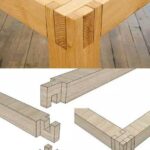Woodworking is a craft that has been around for centuries, and hand planes are essential tools for shaping and smoothing wood. In this article, we will explore the various types of hand planes, their functions, and the importance of using them in woodworking projects. We will also discuss how to properly use a hand plane, common issues and troubleshooting techniques, as well as the differences between hand planes and power planes.
Hand planes are used for shaping, smoothing, and straightening wood surfaces in woodworking projects. These versatile tools are indispensable for achieving precision and accuracy in creating furniture, cabinets, and other wooden items. Whether you are a beginner or an experienced woodworker, understanding how to use different types of hand planes is crucial for achieving professional results.
In the following sections, we will delve into the various types of hand planes available, their specific functions, as well as tips for maintaining and caring for these essential woodworking tools. Additionally, we will provide examples of woodworking projects where hand planes are utilized to demonstrate their significance in creating high-quality wood pieces.
Whether you are interested in honing your woodworking skills or simply curious about the art of using hand planes, this article aims to provide comprehensive insights into their role in woodworking.
Types of Hand Planes and Their Functions
Hand planes are an essential tool in woodworking, used to create a smooth and flat surface on a piece of wood. There are several types of hand planes, each designed for specific functions in woodworking. Here are some common types of hand planes and their functions:
- Jack Plane: The jack plane is the workhorse of the hand plane family. It is used for rough shaping and smoothing of wood, making it an essential tool for any woodworking project.
- Smoothing Plane: As the name suggests, the smoothing plane is used for creating a smooth and polished finish on wood surfaces. It is ideal for removing small imperfections and leveling the wood before applying a final finish.
- Jointer Plane: The jointer plane, also known as the try plane, is designed for straightening and flattening the edges of boards to create seamless joints. It is crucial for producing flat, square edges that are essential in woodworking projects such as cabinetry and furniture making.
Each type of hand plane serves a specific purpose in woodworking, allowing craftsmen to achieve precision and quality in their projects. Whether it’s rough shaping or fine finishing, knowing how to use each type of hand plane effectively can make all the difference in the outcome of a woodworking project.
In addition to these common types, there are also specialty planes such as shoulder planes, block planes, and router planes that serve specific functions in woodworking. Understanding the functions of each type of hand plane is crucial for woodworkers who want to achieve professional results in their craft.
The Importance of Planes in Woodworking
Hand planes play a crucial role in woodworking, allowing craftsmen to achieve smooth and flat surfaces on wood. Their versatility and precision make them essential tools in any woodworker’s arsenal.
Surface Preparation
One of the primary functions of hand planes in woodworking is surface preparation. Before the advent of power tools, hand planes were used to flatten, smoothen, and shape wooden surfaces. Even with modern power tools available, hand planes are still widely used for their ability to produce high-quality finishes that cannot be achieved with machines alone.
Joinery and Fitting
Hand planes are also indispensable when it comes to creating precise joints and fitting components together. The ability to shave off thin layers of wood allows woodworkers to fine-tune the fit of joints like dovetails or mortise and tenon, ensuring a seamless connection between pieces of wood.
Shaping and Molding
In addition to their smoothing and flattening abilities, hand planes are also used for shaping and molding wood. Woodworkers use different types of hand planes to create complex profiles on edges or decorative features on the surface of wooden pieces. This level of customization and detail adds value and uniqueness to woodworking projects.
In summary, hand planes are essential tools in woodworking for preparing surfaces, creating precise joinery and fittings, as well as shaping and molding wood. Their versatility makes them invaluable for achieving high-quality finishes and adding intricate details to woodworking projects.
How to Properly Use a Hand Plane
Using a hand plane in woodworking requires skill and precision to achieve the desired results. Proper usage of a hand plane is crucial for achieving smooth and accurate surfaces on wood. Whether you are a beginner or an experienced woodworker, understanding how to properly use a hand plane is essential for the success of your projects.
Setting Up the Hand Plane
Before using a hand plane, it is important to ensure that the blade is sharp and properly aligned. This can be achieved by using sharpening tools and adjusting mechanisms on the plane itself. Additionally, checking for any debris or rust on the sole of the plane can help prevent any inconsistencies in the planing process.
Planing Techniques
When using a hand plane, it is vital to understand proper planing techniques such as how to hold the plane, applying pressure, and maintaining consistent strokes. Understanding how grain direction affects planing and knowing when to adjust the blade depth are also important factors in achieving smooth and even surfaces.
Finishing and Fine-Tuning
After planing, fine-tuning the surface with sandpaper or a smoothing plane can further refine the wood’s texture. Checking for any imperfections or tear-out and addressing them accordingly will result in a professional and polished final product.
Understanding how to properly use a hand plane not only improves the quality of woodworking projects but also saves time by reducing the need for additional sanding or finishing work. By mastering these techniques, woodworkers can achieve precision and excellence in their craft.
Common Issues and Troubleshooting With Hand Planes
Woodworking with hand planes can be a rewarding experience, but it also comes with its fair share of challenges. Here are some common issues that woodworkers may encounter when using hand planes, along with troubleshooting tips to address them:
1. Clogging: One of the most common problems with hand planes is clogging, especially when working with resinous woods or highly figured grain. To prevent clogging, consider using a plane with a wider mouth to allow shavings to pass through more easily. Additionally, regularly cleaning the blade and adjusting the depth of cut can help minimize clogging.
2. Tearout: Tearout occurs when the wood fibers are not cleanly cut by the plane, resulting in a rough surface. To reduce tearout, try sharpening the plane iron to achieve a finer edge. Adjusting the angle of the blade, known as the “frog,” can also help minimize tearout by controlling the cutting action of the plane.
3. Uneven Planing: If you notice that your hand plane is creating an uneven surface, it may be due to an improperly set blade or an uneven sole (bottom) of the plane. To troubleshoot this issue, make sure that the blade is set evenly across the width of the plane and consider lapping the sole to ensure it is flat and smooth.
Ultimately, identifying and addressing these common issues will enhance your woodworking experience with hand planes and result in cleaner, more precise finishes for your projects.
The Difference Between Hand Planes and Power Planes
Hand planes are an essential tool in woodworking, used for shaping, smoothing, and leveling wood surfaces. Before the invention of power tools, hand planes were the primary tool for these tasks. However, with the advancement of technology, power planes have become popular alternatives to hand planes in woodworking.
Power planes, also known as electric hand planers or surface planers, are motorized tools that perform similar tasks to hand planes but with less manual effort. They are equipped with a rotating cutter head that removes wood quickly and efficiently. Power planes are especially useful for large-scale woodworking projects and for professionals who need to work quickly and accurately.
Despite their similarities in function, there are several key differences between hand planes and power planes. The most obvious distinction is the source of power – hand planes require manual effort to push and pull across the wood surface, while power planes are powered by electricity. Additionally, hand planes offer more control and precision over the wood shaping process compared to power planes. This is particularly important for intricate or detailed woodworking projects where accuracy is paramount.
| Hand Planes | Power Planes |
|---|---|
| Require manual effort | Powered by electricity |
| Offer more control and precision | Remove wood quickly and efficiently |
| Ideal for detailed woodworking projects | Suitable for large-scale projects |
Tips for Maintaining and Caring for Hand Planes
Hand planes are essential tools in woodworking that require proper maintenance and care to ensure their longevity and effectiveness. Regular maintenance not only prolongs the life of hand planes but also ensures that they produce clean, smooth cuts on wood. Properly caring for hand planes involves a few simple steps that can make a significant difference in their performance.
One important aspect of maintaining hand planes is keeping them clean and free of debris. Sawdust and other particles can build up on the blade, causing friction and affecting the quality of cuts. It is recommended to regularly wipe down the blade with a clean cloth or brush to remove any accumulation of sawdust.
Additionally, keeping the plane’s sole clean and smooth is crucial for achieving optimal results. This can be done by periodically lubricating the sole with wax or oil to prevent rusting and ensure smooth movement across the wood.
Another key component of caring for hand planes is ensuring that the blade remains sharp. A dull blade can result in tear-out and rough surfaces on wood, so it is important to sharpen it regularly. This can be done using sharpening stones or honing guides to maintain a fine edge on the blade.
Proper storage of hand planes is also vital for their maintenance, as exposure to moisture and humidity can lead to rusting. Storing them in dry environments and using protective cases or covers when not in use can help prevent corrosion and damage.
It’s clear that properly maintaining and caring for hand planes is crucial for their longevity and performance in woodworking projects. By incorporating regular cleaning, sharpening, and proper storage practices into your routine, you can ensure that your hand planes remain effective tools for creating high-quality woodwork pieces.
| Care | Importance |
|---|---|
| Regular cleaning | Prevents friction from sawdust buildup |
| Blade sharpening | Avoids tear-out and rough surfaces |
| Proper storage | Prevents rusting from moisture exposure |
Examples of Projects That Utilize Hand Planes in Woodworking
In conclusion, hand planes are an essential tool in the woodworking industry, offering precision and control when shaping and smoothing wood. Whether it is for creating intricate designs or achieving a perfectly flat surface, hand planes play a crucial role in woodworking projects. From smoothing out rough surfaces to creating beveled edges and joinery, the versatility of hand planes makes them an indispensable tool for woodworkers of all skill levels.
One of the most common uses for hand planes in woodworking is to create a smooth and even surface on wooden boards. This is particularly important when working with hardwoods or when preparing pieces for joinery. Additionally, hand planes can be used to add decorative details to a piece, such as chamfered edges or unique profiles that enhance the overall aesthetic of the finished product.
Furthermore, whether it’s a small DIY project or a larger scale woodworking endeavor, hand planes are capable of producing professional-level results with proper technique and care. It’s important for woodworkers of all levels to understand not only how to use hand planes effectively but also how to maintain and troubleshoot them when issues arise.
By mastering the use of hand planes, individuals can elevate their woodworking skills and tackle a wide range of projects with confidence and precision.
Frequently Asked Questions
What Is the Purpose of a Wood Planer?
The purpose of a wood planer is to smooth and level the surface of a piece of wood. It is used to create an even, uniform thickness and to remove any imperfections or rough spots from the wood.
What Is a Plane Used For?
A plane is used for shaping and smoothing wood surfaces. It can be used to flatten, reduce the thickness, or create a consistent shape on a piece of wood. Depending on the type of plane, it can also be used for finishing and refining the surface texture of the wood.
What Is the Use of Trying Plane?
A trying plane is specifically designed to flatten large, wide surfaces of wood such as tabletops, doors, or panels. It is larger than other types of planes and is capable of quickly and efficiently leveling out broad areas of wood, making it an essential tool for carpenters and woodworkers working with large pieces of lumber.

Hi everyone! I’m a woodworker and blogger, and this is my woodworking blog. In my blog, I share tips and tricks for woodworkers of all skill levels, as well as project ideas that you can try yourself.





